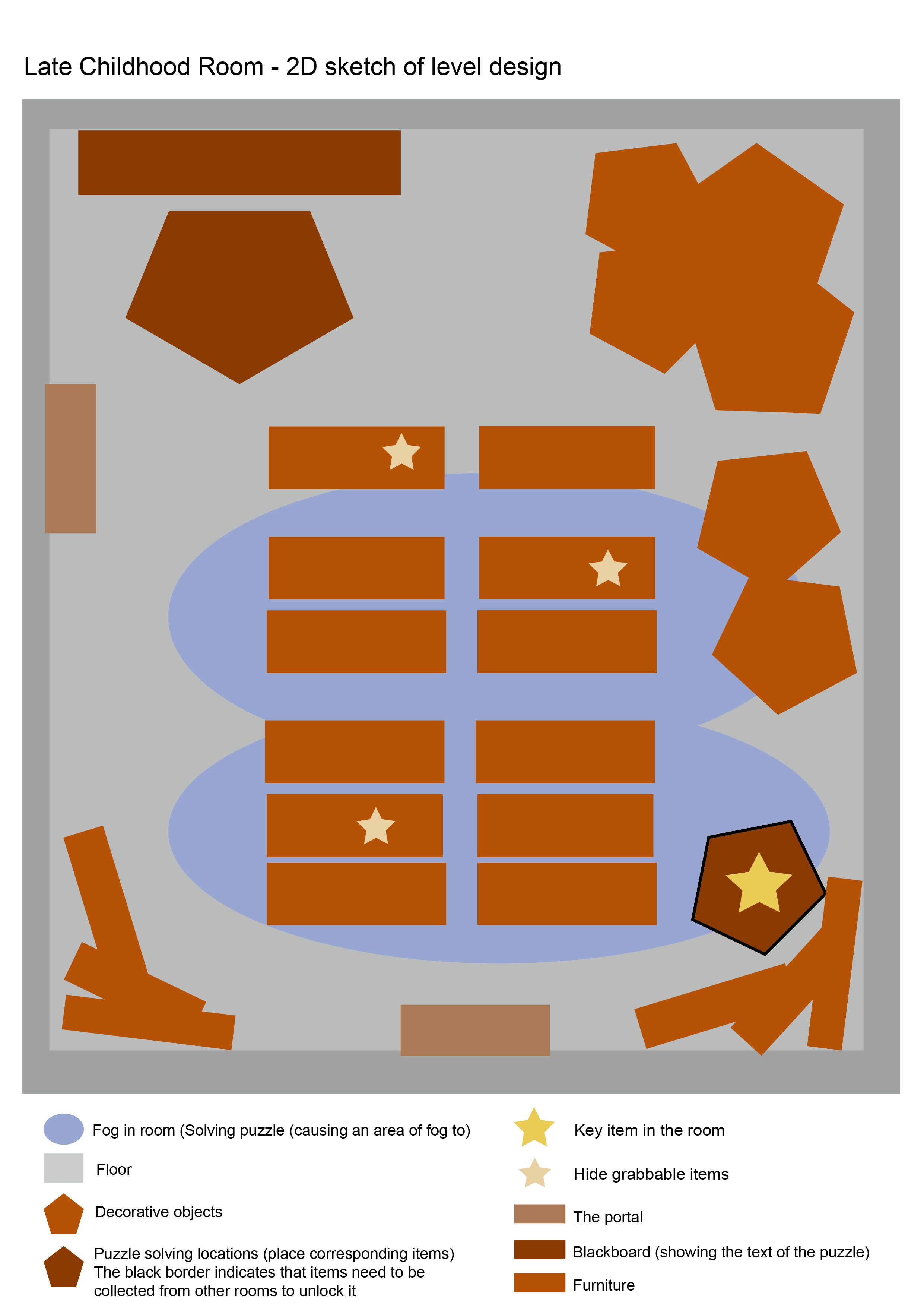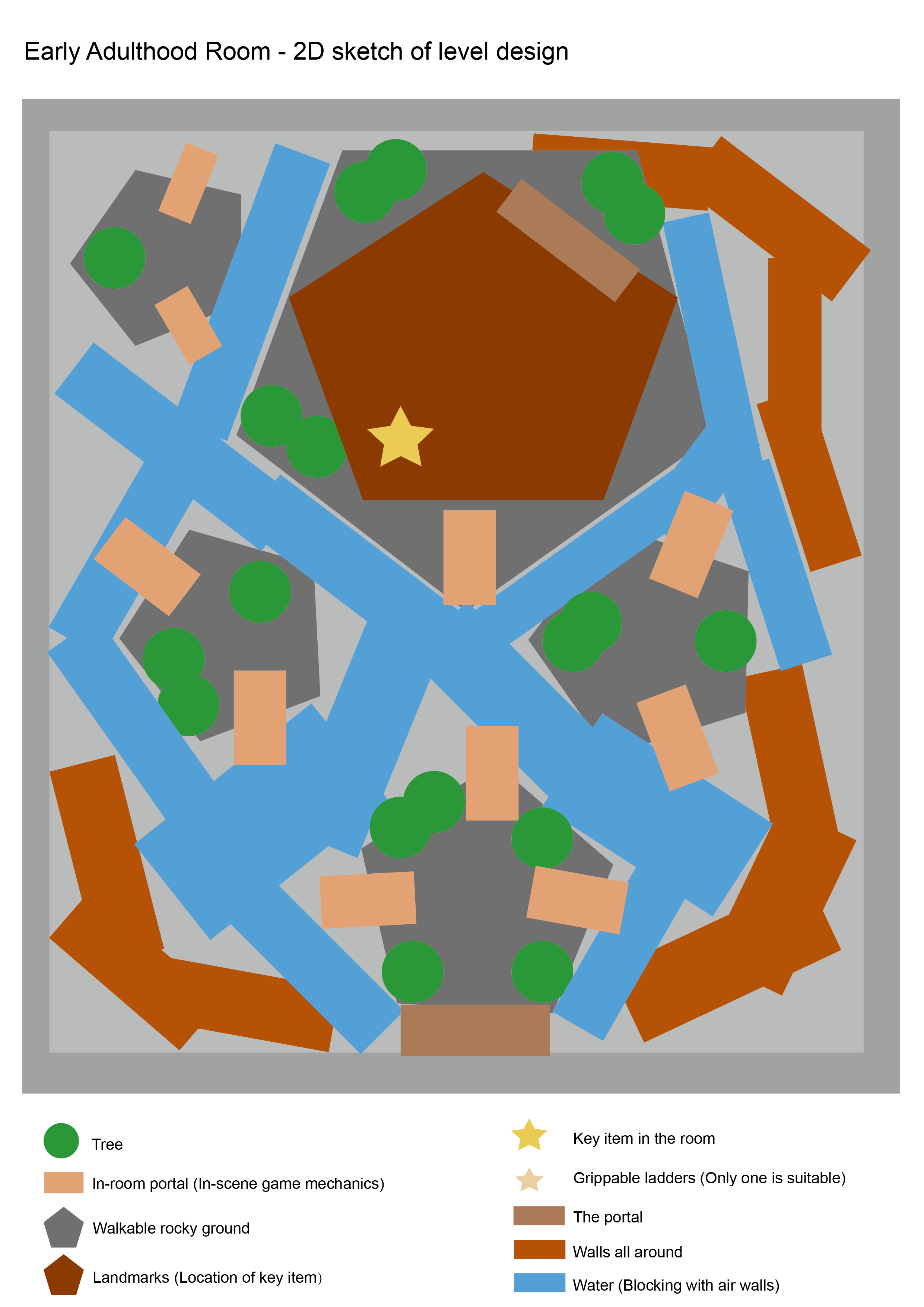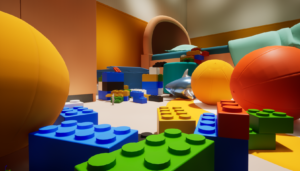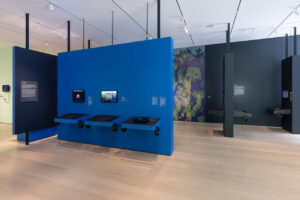For the final game, I updated the classroom music piece, School Days, removing and adding different sections to sound less dramatic/epic/sinister and instead be more curious and full of wonder. I wanted the piece to be more orchestral than the other tracks as there is a sense of formality and order that comes with going to school.
Category: Submission 2
Slides and Video for Presentation
For the final presentation, I made a poster, slides and a short video to introduce our project. Rubik’s cube is the key element of our game, so I used square shaped wireframes as the main content of the poster. And each cube shows elements corresponding to game story. I also added some puzzle elements and used various colors, hoping that this can emphasize the key words of our project, which is “Play”. The scattered puzzles also conform to the concept of the game.

The video will be displayed at the entrance of the room, which provides a brief introduction and guides the audience.
Musical Soundtrack: Early Childhood Room
For the Early Childhood Room, I composed a track called Robot Rhapsody that uses more unnatural and robotic sounding synths to possess a video-game sound. I wanted to create a sense of playful adventure and carefree imaginary worlds, while also bearing elements of soft and sympathetic emotion and compassion that a 6-8 year old child would have.
Musical Soundtrack: Baby Room
For the baby room, I composed a track, Dreaming Baby, predominantly made of soft instruments such as the harp and flutes to reflect the tranquil and dreamy state of the room with its floating clouds and cot. I wanted to capture the freedom and airy nature of dreaming in the musical melodies.
Musical Soundtrack: Late Childhood Class Room
I composed this piece, Classroom Extravaganza, for the class room which seeks to communicate the adventure, exuberance, pressures and unpredictability that going to school brings to a child’s life. It can also be switched for the Early Childhood room if preferred as its sense of adventure could fit that to.
Musical Soundtrack: Adolescence Room
I composed this track for the Adolescence Maze room. I wanted to communicate the ever changing emotions of being a teenager trying to make sense of their place in their world and being challenged to grow emotions amongst feelings of angst and sadness as the losing the innocence and wonder of childhood while being uncertain of what is to come as they grow up.
Game Flow, Narrative Script and Level Diagram
Level Diagram Final Version
I drew up floor plans of all the rooms (levels), using different shapes and colours to represent the information within the game’s level map for subsequent development








Mind Map Final Version
After I further sorted out the mind map, I got the final project game planning document, which contains the core gameplay of the game, different game mechanisms for each room, narrative script, and the entire game process.

4.1 Update Version
I’ve been working on the narrative part of the game with my group members (Ruxin and Zhaoyi) and so far we’ve completed most of the narrative structure and the whole story flow, we’ll refine the details further if we have time.

3.30 Update Version
According to the new gameplay mechanism, the game mechanism in some scenes has been modified, and the ending screen in some scenes has been added to make the whole story provide a stronger sense of substitution.

3.27 Update Version
Based on our meeting and discussion today, I have summarised and collated the completed room environments and gameplay for subsequent development and documentation.
3.23 First Version
I’ve briefly listed the narrative parts we discussed at Monday’s meeting and the flow of the game about my own room, while for the other rooms I’ll refer to everyone’s blogs to populate the document if I have time later.

I have also provided the original brain map file from xMind if anyone would like to edit the contents of the room themselves.
https://drive.google.com/file/d/14jUNTHpsTBNFtiRWmffXV-ZjafzWViah/view?
Reference
https://dream.ai/
Toddlerhood Room detials – Linteng



The life stage in this room is toddlerhood. This room has a variety of toys and legos. Also, this room is different from other rooms, it is really huge, so that the player is only the height as a lego brick inside the room.

Players need to climb over the hills of these blocks, climb up the storage box, then jump on the top of the stool and then climb over another mountain of blocks, and finally climb onto the bed to get the key item.
During this period, players can use the Rubik’s Cube on the ground, push it and fill up the “gully”; they can also use the Lego blocks around them to build a simple “bridge”

Presentation/Exhibition-Research
This was co- written by Ruxin and Alexandria
Inspiration and Execution Plans
Our exhibition was inspired by a video game exhibition done in the MoMa called Never Alone.


In the exhibition in the MoMa, the goal was to make the video games they were showcase accessible, regardless of skill level or any other barrier to entry. Their whole exhibition was build to be inviting, with open spaces and controllers easily at hand so visitors can jump in and start playing whenever they like. “The push for accessibility is also highlighted by the exhibit’s large, street-facing screen, which displays games and beckons passersby to come inside the exhibit gallery. As Galloway remarked, “the way into the museum is from the street.” (Aguasviva, 2022).
Similarly, with working with the constraints of the Atrium’s layout and materials available, we were able to create dynamic sign at entrance of our exhibition that signaled to visitors they were welcome with brief details about the game. We also had a mostly open layout, so we decided to have game stations that created that kind of community play aspect, so visitors could watch people play, and join when a seat became available.
As mentioned in the report on the MoMa exhibition, one of the curator’s Paul said “…games are as much about watching other people play as they are playing yourself, and it becomes this social thing. So we wanted to make sure there were as many opportunities as possible for that.” (Aguasviva, 2022). We wanted to create a similar kind of atmosphere, and though we did not have as big as a venue as MoMa, we used placed projections of pre-recorded game play using white projector screens to create the different opportunities for play to be witnessed and experienced by more people in we didn’t have room to make as many stations as the MoMa.
All in all, our goal was to create an environment that made people curious about our game, and invoke feelings of curiosity and play as they walked around the room and watched other people play, be it the visuals on the large projector screens or seeing others sitting at the tables and playing.
Sketch and plans
a. There are two areas for the audience to play the game, and there are two computer devices per area. The curtains around the two areas will be closed. We can use the TV to show the introduction slides of the project. Two projectors will display some video clips of the game.

b. There will be four computers in the corners of the room, which allow audience to play the game. The location of the projectors and TV remains the same.
Final Decision and Layout
There are four areas for the audience to play the game, each of them has a monitor, a laptop, headphones, and a mouse and keyboard. There is a display screen at the entrance of the room, which displays a brief project introduction. Two projectors will each project the same video, which includes game clips and introductions. There are two speakers in the center of the room, playing background music from the game. The entire room is dimly lit to create an immersive atmosphere where it’s the glow of the screens and video being seen.
Musical Soundtrack: Toddlerhood Room
For the toddlerhood/toy room, I made the following track, Imagination Playstation, to represent the energetic, excitable and hype imagination of a child. I wanted the hyperactive melody to capture the mischievous, curious and waddling nature of a toddler.
